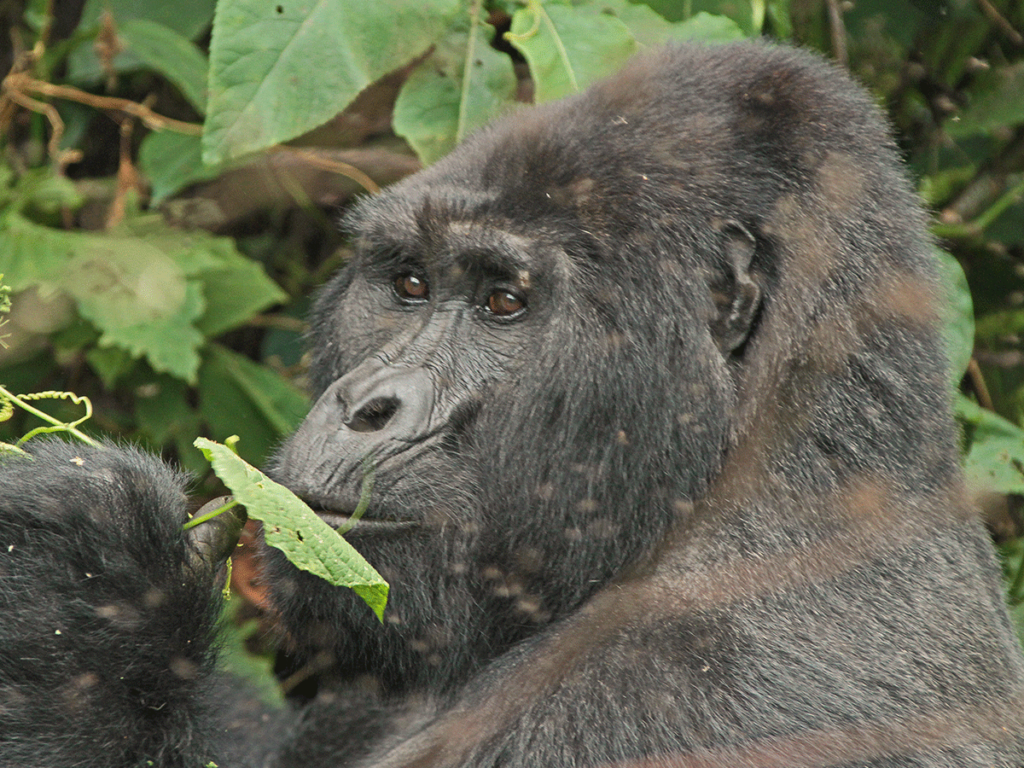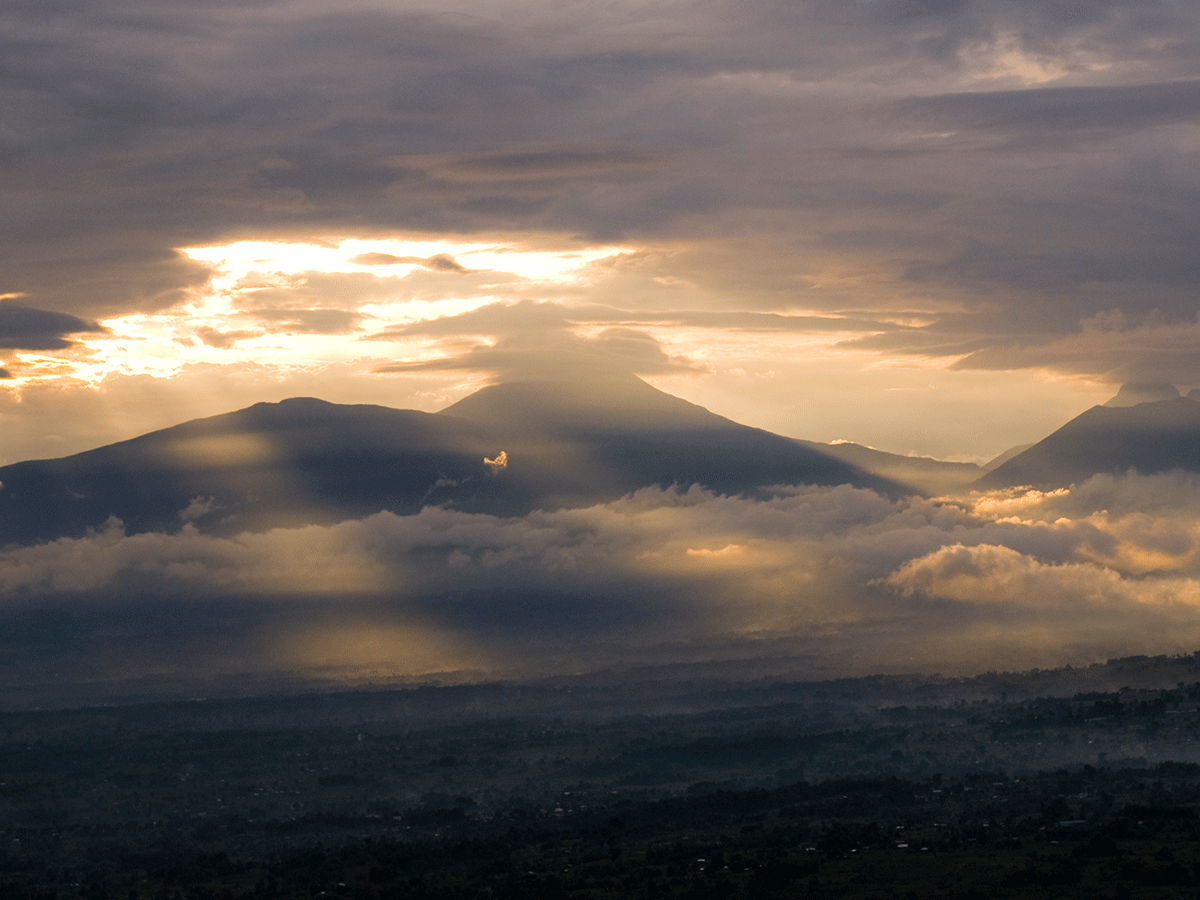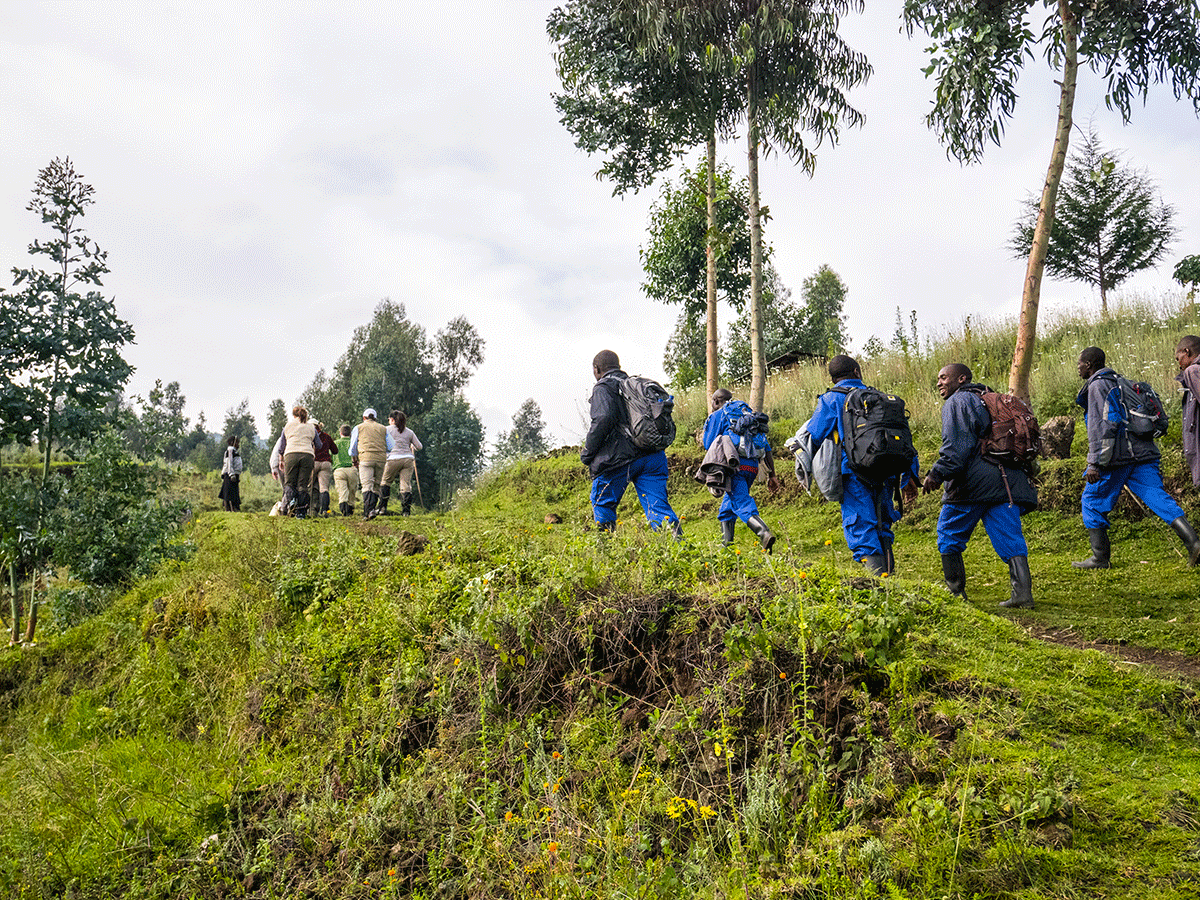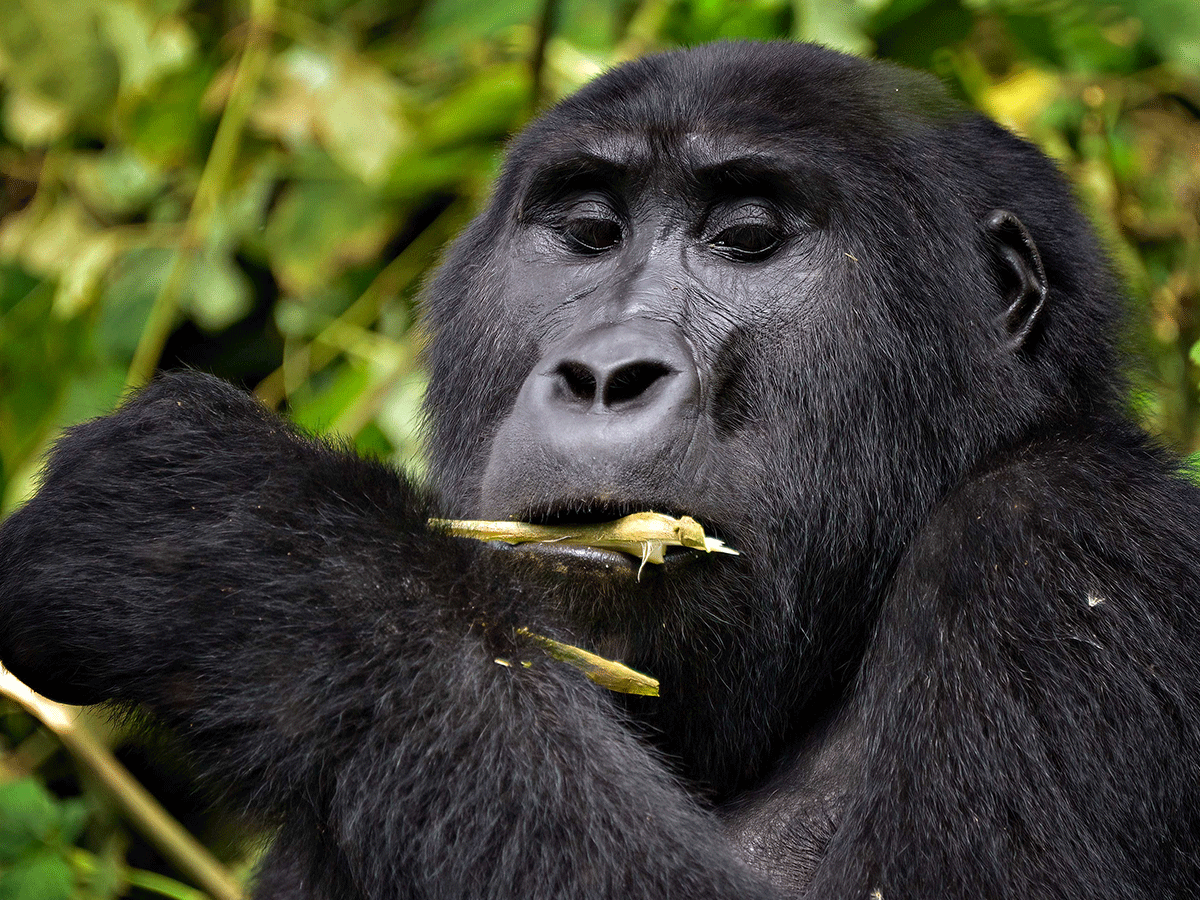Annual Wildebeest Migration
Annual Wildebeest Migration
Tanzania’s Serengeti and Kenya’s Masai Mara ecosystems form the backdrop to one of the most breathtaking events in the entire animal kingdom, the Annual wildebeest migration is an annual movement of a large group of animals of about 2 million, the largest wildlife being the wildebeest some zebras and gazelle that move from Serengeti national park northwards to Masai Mara National Park and back to Serengeti. The park is well known for its large concentration of big cats like lions, cheetahs, and hyenas. This migration is one of the prime attractions of the park. Other animals in the park include elephants, leopards, buffalo, giraffes, and many antelopes Serengeti National Park is a fascinating place for wildlife viewing throughout the year.
What to expect during the Wildebeest Migration
The great migration usually takes place in an area of about 40, 000 square kilometres pretty much defined by the dominant migration routes of the white-bearded wildebeest in what is regarded o as the Masai Mara and Serengeti ecosystem which is divided by the Mara River so being at the right time at the right place is all that it takes to witness the River crossing as the Wildebeest do not have defined crossing points, the crossing points change time to time depending on the obstacles faced as the wildebeest trek from southern Serengeti through the western corridor crossing Lakes and Rivers.
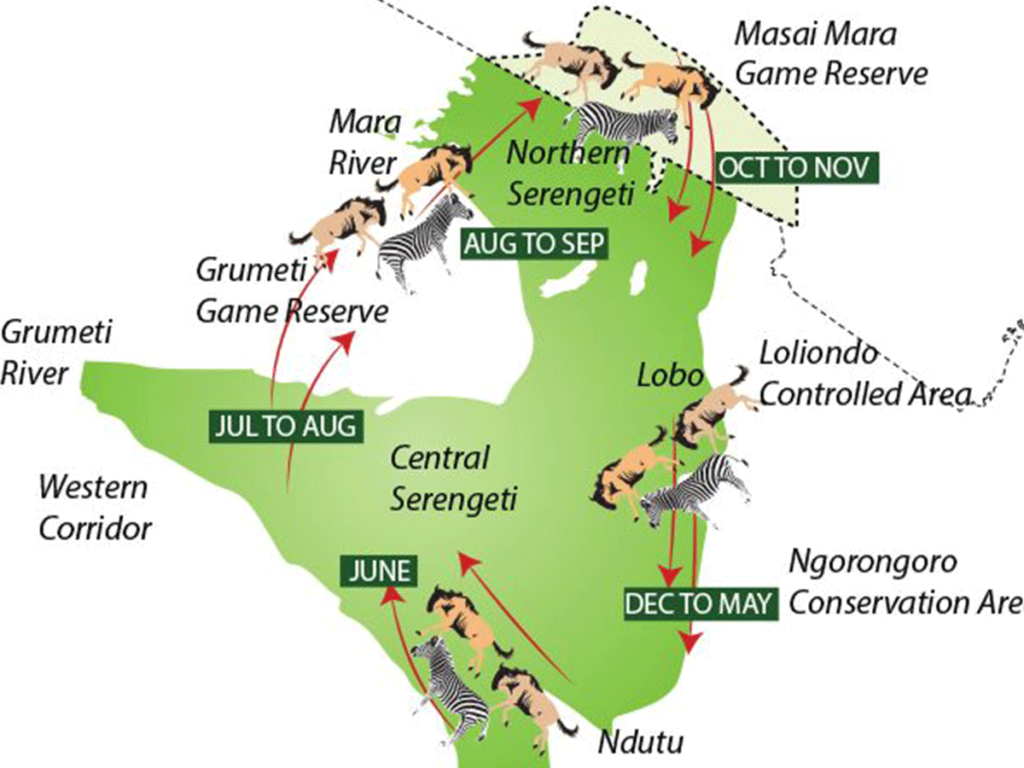
Wildlife during the annual wildebeest Migration
Over 1.6 million wildebeest will lead the way as the rains approach in the Serengeti in late October or November and this is accompanied by 400,000 Thomson’s gazelle, 300,000 Zebra, and 12,000 Eland. These are the main migrators and they cross the ranges of over a quarter of a million other resident herbivores and, of course, carnivores. The lions, hyenas, leopards, cheetahs, and lesser predators will always follow the migration and this will be evident as more numbers of predators are seen following the wildebeest migration at the beginning of the circle.
The wildebeest calving season
The Great wildebeest migration build-up to the annual wildebeest migration usually starts in January and February, when the wildebeest cows drop their young at the same time or rate that sees some 7000 to 8000 calves are born every day and within two to three weeks after eight and a half months after the rutting season.
The annual calving season is really action-packed in the Serengeti as it provides a feast for predators. A safari across the plains will see clients count literally hundreds of hyenas and dozens of lions scattered around the huge herds of the wildebeest.
Life of the wildebeest calves
Newborn wildebeest calves gain coordination faster than any other ungulates and are usually on their feet two to three minutes after birth. It can run with the herd at the age of five minutes and can outrun a lioness soon thereafter. Notwithstanding this, many do die within their first year, from predation (although research indicates only about one per cent die this way), malnutrition, fatigue or disease causes more impact on the wildebeest calves.
Wildebeest rutting season
This is the time of the annual rut, with half a million cows mated in less than a month as the herds consolidate in the woodlands and on the plains of the Serengeti’s Western Corridor. The peak of the rut seems heavily influenced by the state of the moon, with the full moon in May or June being a good bet for anyone seeking the most action.
Seemingly vicious fighting between dominant or territorial males takes place during the rut, though there is generally little actual violence or serious injury. And despite these energetic duels, the males have little say over their choice of mates, for it is the females who do the actual choosing.
The Actual Mara River crossing
Wildebeest arrive at the Mara River in tens of thousands and gather waiting to cross. For days their numbers can be building up and anticipation grows but many times, for no apparent reason, they turn and wander away from the water’s edge. Eventually, the wildebeest will choose a crossing point, something that can vary from year to year and cannot be predicted with any accuracy. Usually, the chosen point will be a fairly placid stretch of water without too much predator-concealing vegetation on the far side, although occasionally they will choose seemingly suicidal places and drown in their hundreds.
Closing the Circle of the Wildebeest migration
By late October, when the first short rains are falling on the Serengeti’s short-grass plains, filling seasonal waterholes and bringing new flushes of growth, the wildebeest start heading south again. The herds trek down through the Eastern woodlands of the Serengeti, some 90 per cent of the cows are heavy with the new-season young ones. Tightly grouped as they pass through the wooded countryside the wildebeest scatter and spread out again once they reach the open plains and that marks the end of the circle. By January and February again the wildebeest start a new circle.
Predators during the Annual wildebeest migration
Some of the common predators during the Annual Wildebeest migration are Lions, cheetahs, Hyenas, leopards, and jackals will follow along together with vultures.
Best time to see the Annual wildebeest migration
The best time to be in Serengeti largely depends on what you are looking for and we highly recommend February and early March when the wildebeest calving is taking place where over 7000 wildebeest calves are born within 3 weeks in the heavy presence of predators and during July to October when the wildebeest Mara River crossing taking place, this is one of the dramatic wildlife scenes in Africa where the wildebeest cross in presence of big Nile crocodiles and sometimes heavy currents.
Summery of the Annual wildebeest Migration
| MONTH | WHERE TO GO | EXPERIENCE |
|---|---|---|
| Jan - March | Ndutu area & Southern Serengeti | Calving season |
| April - June | Western & Central Serengeti | Wildebeest Rut |
| July - September | Northern Serengeti & Masai Mara Kenya | River crossing |
| October-December | Serengeti &Masai mara or on the Move to Southern Serengeti |
Detailed breakdown
January
In January, wildebeest and zebra herds continue to move south, mostly along the eastern edge of the Serengeti toward the fresh short grasses of the Ndutu plains, while much of the migration has already arrived in the southern Serengeti near Lake Ndutu where the animals will graze and prepare to drop their young. Large herds dot the plains as far as the eye can see and predators watch the herds closely.
February
In February, the calving season is in full effect as huge herds of wildebeest dot the vast grassy plains of the southern Serengeti and Ngorongoro Conservation Area, all dropping their young in a two- to a three-week span of time, with predators ever-present and ready to hunt the weak and vulnerable members of the herds.
March
In March, the herds of nearly two million wildebeest and zebra remain fairly stationary; feasting on fresh grasses in the southern plains of the Serengeti and Ndutu, as their new calves grow stronger and prepare to move north. A hot-air balloon safari over the plains is a great way to get a perspective on how truly massive the herds are.
April
In April, the herds begin to journey north toward the central and western sectors of the Serengeti national park and the Grumeti River. Many camps close this month for maintenance, as April also marks the beginning of the long rains in East Africa. With the migration on the move, it can be a good time to stay in central Serengeti.
May
In May, the migration pushes northwest into the western corridor of the Serengeti the herds tend to stagger, with some arriving in the western reaches of the park near the Grumeti River first, while others can still be found farther south and near the central area of the park. Those that reach the western edge first tend to venture into the private Grumeti Reserve bordering the park. At the end of the month, they begin to form a mega-herd again.
June
In June, a large migration herd is formed in the western Serengeti on the southern banks of the Grumeti River, with some smaller groups farther east in the central Seronera area of the park. The wildebeest and zebra tend to grow into a mega-herd before crossing the crocodile-filled Grumeti River to continue north. June also begins the rutting, or breeding, the season for the wildebeest, creating a lot of activity and excitement amongst the herds, as males exhibit their prowess and fight for female favor.
July
In July, as available grasses are exhausted and begin to dry, the herds move northward for fresh grazing. With some of the herd still in the Western Serengeti and Grumeti Reserve, they continue to move northeast in search of greener plains, many arriving at the Mara River and Lamai Triangle in the northern Serengeti in mid-to late-July. These front-runners may begin the treacherous crossing of the crocodile-filled Mara River, while others graze in the northern Serengeti.
August
In August, wildebeest and zebra herds begin their annual crossing of the Mara River, which cuts across the northwest corner of the Serengeti and up through the Masai Mara. They continue in search of fresh grasses on the other side of the river. While herds pour across the unfenced border into Kenya, some also stay in the northern Serengeti, though river crossings, though unpredictable, can be seen almost daily at this time of year.
September
In September, the migration herds continue to arrive and feed on the grasses in Kenya’s greater Masai mara viewing wildebeest and zebra crossing the Mara River in herds is also still a common occurrence. The abundant local wildlife only enhances the overall experience, and this is simply an excellent time of year to be in Kenya.
October
In October, the migration can still be found in the Masai Mara and northern Serengeti as herds continue to graze in large numbers with lions and other predators always in the vicinity. River crossings can still be seen on occasion. As the short rains begin to brew toward the end of October, the first of the herds begin to journey back south along the eastern edge of the Serengeti and Loliondo following new grasses.
November
In November, the short rains have begun to fall, and the bulk of the migration herds move quickly south with the goal of reaching the short-grass plains once again. The mega-herd breaks into pockets of wildebeest and zebra that can be found in the northern Serengeti moving to the central Seronera plains, while many are found along the eastern border near the private reserves of Loliondo.
December
In December, the migration continues moving south toward the short-grass plains of Ndutu in the Ngorongoro Conservation Area. Some herds can be spotted in the central and eastern Serengeti as they move south, while early arrivals can be found already in Ndutu feasting on fresh grasses. This is a nice time to see large herds thundering across the plains and beginning to gather in the south.
Where to stay in Masai mara and Serengeti to see the wildebeest migration
The Mara Triangle is one third of the Maasai Mara National Reserve, with an area of 510 km². It has two natural borders and one political; to the southwest is the Tanzania/Serengeti border, to the east is the Mara River, and to the northwest is the Oldoinyio Escarpment (also called Oloololo or Siria Escarpment).
The Kogatende area in the northern Serengeti is a great place to catch the migration, between July and October but with July and August typically the peak months. There is a permanent pride of lions in the area that you can see year-round, along with other leopards and cheetahs.
Best time to see the wildebeest migration in East Africa
July through November is traditionally considered the best time to view the Great Migration. Between July and August, the wildebeest move in masses into Kenya's Maasai Mara, crossing the Mara River in staggering numbers. For travelers, river crossings rank among the most sought-after moments of the Great Migration.
START PLANNING YOUR SAFARI NOW!
Talk to one of our African adventure experts and let them tailor-make your safari
You might also be interested in...
Our experts have hand-picked further safari packages to suit your adventure dreams.
Inspirational journeys
